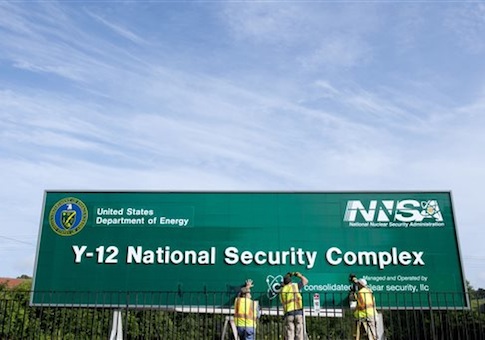The organization responsible for securing America’s highly sensitive nuclear sites has been suffering from a "chaotic" and "dysfunctional" security policy that has endangered the country’s nuclear sites and left them vulnerable to attack, according to a new report by the government’s watchdog group.
The National Nuclear Security Administration (NNSA), which is tasked with managing the nation’s nuclear stockpile and securing classified research sites, has "increased risks and reduced security" over the past several years in a bid to reduce overhead costs, according to a new Government Accountability Office (GAO) report.
Security vulnerabilities at these NNSA sites still persist two years after a major breach at one of its top facilities in Tennessee. The administration’s own officials have described the security policy as "chaotic" and "dysfunctional," according to the report.
Further security reforms put in place since the 2012 breach at the Y-12 National Security Complex (Y-12) in Tennessee have not effectively mitigated risks posed to this facility and others across the nation, according to the report, which urged the NNSA to develop a clear security plan going forward.
The schizophrenic security procedures, which often vary from facility to facility, have not effectively been addressed by the NNSA, which still cannot "fully [resolve] long-standing security management and oversight problems," according the report.
"NNSA may prolong what some of its own officials have described as a ‘chaotic’ or ‘dysfunctional’ period in NNSA's security program since the 2012 security breach," according to the report. "In addition, NNSA risks putting in place short-lived or ineffective responses to its security problems, on which GAO and others have reported for more than a decade."
Severe security gaps were first identified in July 2012 after "three trespassers gained access to the protected area directly adjacent to one of the nation’s most critically important nuclear weapon-related facilities" at the Y-12 facility.
However, reforms put in place in the years since the breach lack "a clear vision and path forward," according to the report.
"NNSA took a number of actions designed to improve its security performance and oversight but did so without first developing a clear vision and path forward for its security program and an implementation strategy, including milestones and responsibilities for carrying them out," according the report.
The problems first began in 2009, when the NNSA attempted to reform its security measures in a bid to cut costs of about $53 million.
These reforms—which allowed independent contractors working for the NNSA to assume "greater authority to make security decisions and accept risks"—actually "increased security risks and reduced security performance" at Y-12 and other sites, according to the report.
NNSA officials and contractors reported to the GAO "that some recommendations made during the reviews may have encouraged inappropriate risks by, for example, calling for cuts in what some of the officials or contractors described as critical protective force posts and patrols," according to the report. "Other actions to implement the reforms may also have increased risks, particularly at Y-12" and likely contributed to the 2012 security breach.
As these reforms were being implemented, the Department of Energy (DOE) and "NNSA scaled back on their security inspections and increased their reliance on contractors to self-monitor and self-evaluate their security performance at NNSA sites," the report found.
Since the time of the Y-12 security breach the NNSA has started and stopped several new security programs and failed to identify a clear plan going forward, according to the report.
The NNSA, among other things, "started, then discontinued, a security inspection program" and also "reorganized its headquarters security office twice," according to the report. "NNSA undertook these and other actions without first developing the NNSA security "road map" that its Security Task Force had called for in 2012, as a priority recommendation after the Y-12 breach."
The GAO continues to urge the NNSA to develop and implement a clear security plan that can adequately protect facilities from risks.
